| Weight | 1 lbs |
|---|---|
| Dimensions | 9 × 5 × 2 in |
| host | mouse |
| isotype | IgG |
| clonality | monoclonal |
| concentration | concentrate, predilute |
| applications | IHC |
| reactivity | human |
| available size | 0.1 mL, 0.5 mL, 1 mL concentrated, 7 mL prediluted |
rabbit anti-Topoisomerase IIa monoclonal antibody (ZR94) 6388
Price range: $160.00 through $528.00
Antibody summary
- Rabbit monoclonal to Topoisomerase IIa
- Suitable for: Immunohistochemistry (formalin-fixed, paraffin-embedded tissues)
- Reacts with: Human
- Isotype:IgG
- Control: Tonsil
- Visualization: Nucleus
- 0.1, 0.5, 1.0 mL concentrated, 7 mL prediluted
rabbit anti-Topoisomerase IIa monoclonal antibody ZR94 6388
| target relevance |
|---|
| Protein names DNA topoisomerase 2-alpha (EC 5.6.2.2) (DNA topoisomerase II, alpha isozyme) |
| Gene names TOP2A,TOP2A TOP2 |
| Protein family Type II topoisomerase family |
| Mass 174385Da |
| Function FUNCTION: Key decatenating enzyme that alters DNA topology by binding to two double-stranded DNA molecules, generating a double-stranded break in one of the strands, passing the intact strand through the broken strand, and religating the broken strand (PubMed:17567603, PubMed:18790802, PubMed:22013166, PubMed:22323612). May play a role in regulating the period length of BMAL1 transcriptional oscillation (By similarity). {ECO:0000250|UniProtKB:Q01320, ECO:0000269|PubMed:17567603, ECO:0000269|PubMed:18790802, ECO:0000269|PubMed:22013166, ECO:0000269|PubMed:22323612}. |
| Catalytic activity CATALYTIC ACTIVITY: Reaction=ATP-dependent breakage, passage and rejoining of double-stranded DNA.; EC=5.6.2.2; Evidence={ECO:0000255|PROSITE-ProRule:PRU00995, ECO:0000269|PubMed:19222228, ECO:0000269|PubMed:19697956}; |
| Subellular location SUBCELLULAR LOCATION: Cytoplasm {ECO:0000269|PubMed:9155056}. Nucleus, nucleoplasm {ECO:0000269|PubMed:8299728}. Nucleus {ECO:0000269|PubMed:17567603, ECO:0000269|PubMed:22013166, ECO:0000269|PubMed:8299728, ECO:0000269|PubMed:9155056}. Nucleus, nucleolus {ECO:0000269|PubMed:9155056}. |
| Tissues TISSUE SPECIFICITY: Expressed in the tonsil, spleen, lymph node, thymus, skin, pancreas, testis, colon, kidney, liver, brain and lung (PubMed:9155056). Also found in high-grade lymphomas, squamous cell lung tumors and seminomas (PubMed:9155056). {ECO:0000269|PubMed:9155056}. |
| Structure SUBUNIT: Homodimer. Interacts with COPS5. Interacts with RECQL5; this stimulates DNA decatenation. Interacts with SETMAR; stimulates the topoisomerase activity (PubMed:18790802, PubMed:20457750). Interacts with DHX9; this interaction occurs in a E2 enzyme UBE2I- and RNA-dependent manner, negatively regulates DHX9-mediated double-stranded DNA and RNA duplex helicase activity and stimulates TOP2A-mediated supercoiled DNA relaxation activity (PubMed:12711669). Interacts with HNRNPU (via C-terminus); this interaction protects the topoisomerase TOP2A from degradation and positively regulates the relaxation of supercoiled DNA in a RNA-dependent manner (By similarity). Interacts with MCM3AP isoform GANP (PubMed:23652018). Interacts with ERCC6 (PubMed:26030138). Interacts with PLSCR1 (PubMed:17567603). Interacts with GCNA; this interaction allows the resolution of topoisomerase II (TOP2A) DNA-protein cross-links (By similarity). Interacts with POL1RA/RPA1 (via dock II) and UBTF in the context of Pol I complex; may assist Pol I transcription initiation by releasing supercoils occurring during DNA unwinding. Interacts with TPRN; TPRN interacts with a number of DNA damage response proteins, is recruited to sites of DNA damage and may play a role in DNA damage repair (PubMed:23213405). {ECO:0000250|UniProtKB:P41516, ECO:0000250|UniProtKB:Q01320, ECO:0000269|PubMed:12711669, ECO:0000269|PubMed:15126503, ECO:0000269|PubMed:16100112, ECO:0000269|PubMed:17567603, ECO:0000269|PubMed:20457750, ECO:0000269|PubMed:22013166, ECO:0000269|PubMed:22841979, ECO:0000269|PubMed:23213405, ECO:0000269|PubMed:23652018, ECO:0000269|PubMed:26030138, ECO:0000269|PubMed:36271492}. |
| Post-translational modification PTM: Phosphorylation has no effect on catalytic activity. However, phosphorylation at Ser-1106 by CSNK1D/CK1 promotes DNA cleavable complex formation. {ECO:0000269|PubMed:10942766, ECO:0000269|PubMed:18062778, ECO:0000269|PubMed:19043076, ECO:0000269|Ref.11}.; PTM: (Microbial infection) Deubiquitinated by Epstein-Barr virus BPLF1; leading to stabilized SUMOylated TOP2A trapped in cleavage complexes, which halts the DNA damage response to TOP2A-induced double-strand DNA breaks. {ECO:0000269|PubMed:34543352}.; PTM: SUMOylated. {ECO:0000269|PubMed:34543352}. |
| Domain DOMAIN: The N-terminus has several structural domains; the ATPase domain (about residues 1-265), the transducer domain (about 266-428) and the toprim domain (455-572) (PubMed:25202966). Comparing different structures shows ATP hydrolysis induces domain shifts in the N-terminus that are probably part of the mechanism of DNA cleavage and rejoining (PubMed:25202966). {ECO:0000250|UniProtKB:P0AES6, ECO:0000269|PubMed:25202966}. |
| Target Relevance information above includes information from UniProt accession: P11388 |
| The UniProt Consortium |
Data
 |
| Formalin-fixed, paraffin-embedded human squamous cell carcinoma stained with anti-Topoisomerase IIa antibody using peroxidase-conjugate and DAB chromogen. Note nuclear staining of tumor cells |
Publications
| pmid | title | authors | citation |
|---|---|---|---|
| We haven't added any publications to our database yet. | |||
Protocols
| relevant to this product |
|---|
| IHC |
Documents
| # | SDS | Certificate | |
|---|---|---|---|
| Please enter your product and batch number here to retrieve product datasheet, SDS, and QC information. | |||
Only logged in customers who have purchased this product may leave a review.
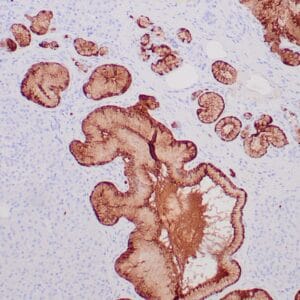

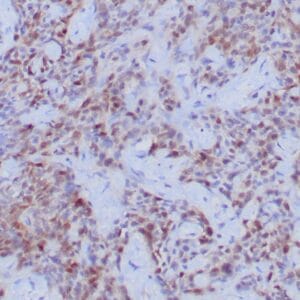
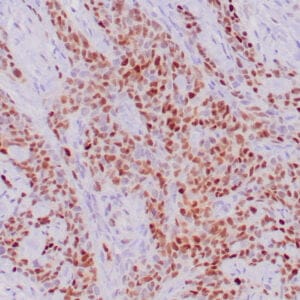
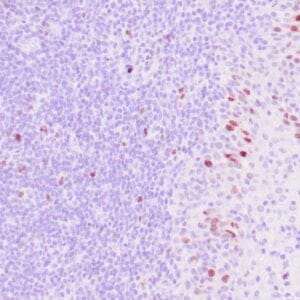
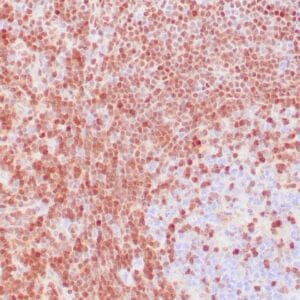

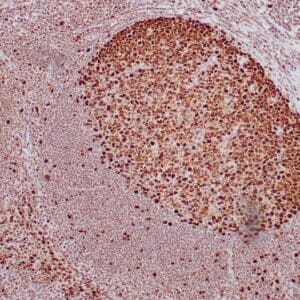
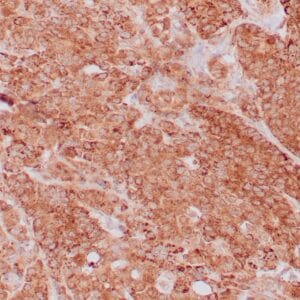
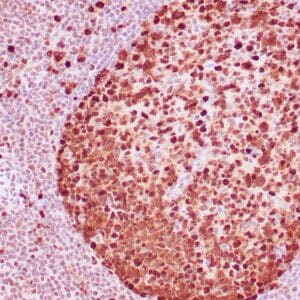


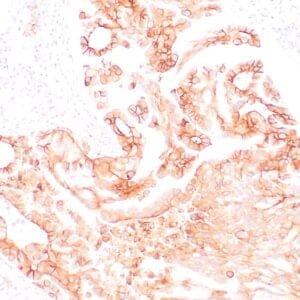
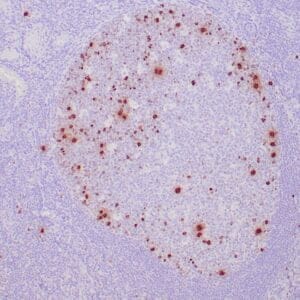

Reviews
There are no reviews yet.